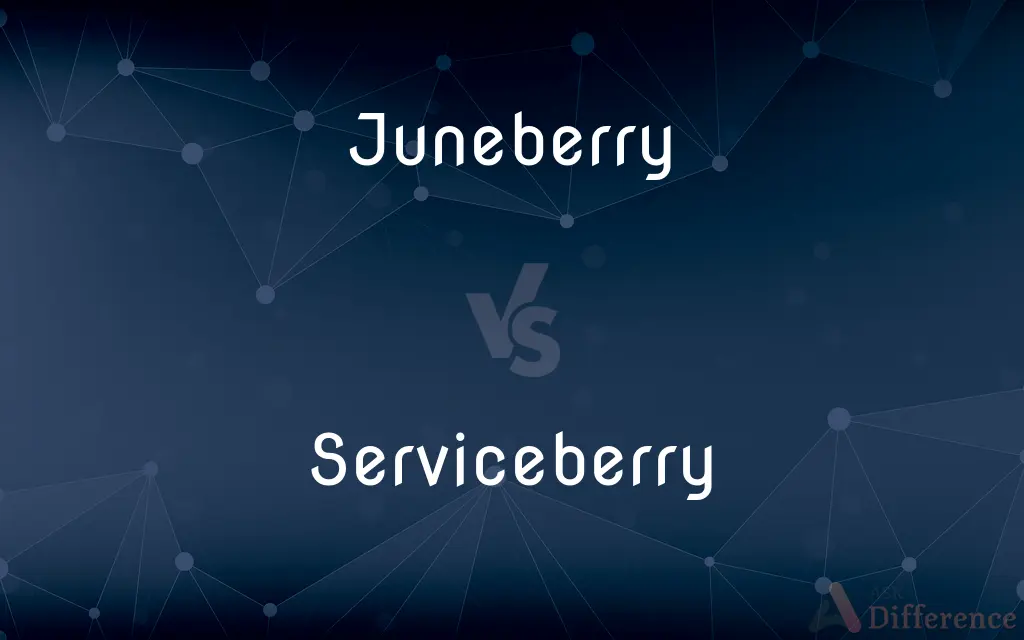Juneberry vs. Serviceberry — What's the Difference?
By Tayyaba Rehman & Urooj Arif — Updated on May 4, 2024
Juneberry trees are celebrated for their sweet, dark purple fruits and smooth gray bark, whereas serviceberry trees, although similar, are noted for slightly different fruit flavors and often more varied bark textures.

Difference Between Juneberry and Serviceberry
Table of Contents
ADVERTISEMENT
Key Differences
Juneberries are a type of deciduous shrub or small tree belonging to the genus Amelanchier. Their fruits are edible, dark purple, and resemble blueberries in taste and appearance. Whereas, serviceberries, also part of the Amelanchier genus, produce similar edible berries that are slightly less sweet and can vary more in color from red to purple.
In terms of flowering, juneberries bloom in early spring with white flowers that attract pollinators. On the other hand, serviceberries also bloom with white flowers, but their flowering season can extend slightly later into spring depending on the species.
The bark of juneberry trees is typically smooth and gray, which can help in identifying them in the wild. Whereas, serviceberry trees might have slightly rougher bark with more textural variations, which can include stripes or patches.
Culturally, juneberries have been important in native diets and medicine, known for their nutritional value. Serviceberries share this cultural significance, but they have also been used more extensively in landscape gardening due to their adaptive nature and aesthetic appeal.
Regarding habitat, juneberries are adaptable but prefer well-drained, slightly acidic soil. Serviceberries, while also adaptable, are more tolerant of different soil types and conditions, making them a more versatile choice for various landscapes.
ADVERTISEMENT
Comparison Chart
Botanical Name
Amelanchier spp.
Amelanchier spp.
Fruit Taste
Sweet, similar to blueberries
Less sweet, variable red to purple
Bark Texture
Smooth, gray
More varied, can be slightly rough
Flowering Season
Early spring
Spring, sometimes extends later
Cultural Significance
Native diets and medicine
Landscape gardening, native diets
Compare with Definitions
Juneberry
Produces edible berries that are dark purple and nutritious.
Juneberries are rich in antioxidants and vitamins.
Serviceberry
A deciduous tree or shrub also producing edible berries.
We use serviceberries to make jams and pies.
Juneberry
Belongs to the genus Amelanchier.
The juneberry is a member of the Amelanchier genus.
Serviceberry
Berries can vary in sweetness and color.
The serviceberries this year are less sweet than usual.
Juneberry
A type of shrub or small tree known for its sweet fruit.
We picked juneberries from the shrub in our backyard.
Serviceberry
Also part of the Amelanchier genus.
Serviceberries are closely related to juneberries.
Juneberry
Flowers in early spring with white blossoms.
The juneberry tree in the park is in full bloom.
Serviceberry
Used extensively in landscaping for aesthetic purposes.
The serviceberry trees have been planted along the avenue.
Juneberry
Has smooth, gray bark that distinguishes it from other trees.
The smooth bark of the juneberry makes it easy to identify.
Serviceberry
Tolerates a variety of soil conditions.
Serviceberry trees thrive in both wet and dry soils.
Juneberry
See serviceberry.
Serviceberry
Any of various shrubs or trees of the genus Amelanchier of the rose family, chiefly found in North America, having clusters of white flowers and edible red to dark purple fruit. Also called service tree, shadblow, shadbush.
Juneberry
Any of several North American trees of the genus Amelanchier, having white flowers and edible, purplish fruit.
Serviceberry
The berrylike fruit of this tree. In both senses also called juneberry, shadberry.
Juneberry
The fruit of such a tree.
Serviceberry
(Europe) Several species of trees in the genus Sorbus, especially Sorbus domestica and Sorbus torminalis.
Juneberry
The small applelike berry of American trees of genus Amelanchier; - also called service berry.
Serviceberry
The berries of those trees
Juneberry
Any of various North American trees or shrubs having showy white flowers and edible blue-black or purplish fruit
Serviceberry
(North America) Any plant of the genus Amelanchier of small deciduous trees and large shrubs in the family Rosaceae.
Juneberry
Edible purple or red berries
Serviceberry
The berry of such a plant.
Serviceberry
Any of various North American trees or shrubs having showy white flowers and edible blue-black or purplish fruit
Serviceberry
Edible purple or red berries
Common Curiosities
How do serviceberries differ in taste from juneberries?
Serviceberries are generally less sweet and can vary more in flavor.
Are juneberries and serviceberries the same genus?
Yes, both belong to the Amelanchier genus.
What are the main differences in the bark of juneberries and serviceberries?
Juneberry bark is smoother and more uniformly gray, while serviceberry bark can be more varied and textured.
Are both juneberries and serviceberries native to North America?
Yes, both species are native to various parts of North America.
What is the best time to plant juneberries?
Early spring or fall is ideal for planting juneberries.
What are juneberries commonly used for?
Juneberries are often used in pies, jams, and fresh eating.
How long do juneberry and serviceberry trees typically live?
They can live for several decades with proper care.
What are the best uses for serviceberries in the kitchen?
Serviceberries are great for baking, making jellies, and even in salads.
Can serviceberries be used in landscaping?
Yes, serviceberries are popular in landscaping due to their beautiful flowers and adaptable nature.
What are the typical heights for mature juneberry and serviceberry trees?
Both can grow up to 15-25 feet tall, depending on the species and environmental conditions.
How do the nutritional values of juneberries and serviceberries compare?
Both are nutritious, offering vitamins, minerals, and antioxidants, though specific nutrient profiles can vary.
Can both juneberries and serviceberries grow in partial shade?
Yes, both can tolerate and thrive in partial shade conditions.
How do the flowering times of juneberries and serviceberries compare?
Juneberries typically flower earlier in the spring compared to serviceberries.
What wildlife benefits from juneberries and serviceberries?
Birds and small mammals commonly eat the berries of both trees.
Are there any known pests that significantly affect juneberries and serviceberries?
Both can be susceptible to common pests like aphids and mites.
Share Your Discovery

Previous Comparison
Bromide vs. Bromate
Next Comparison
Burgled vs. BurglarizedAuthor Spotlight
Written by
Tayyaba RehmanTayyaba Rehman is a distinguished writer, currently serving as a primary contributor to askdifference.com. As a researcher in semantics and etymology, Tayyaba's passion for the complexity of languages and their distinctions has found a perfect home on the platform. Tayyaba delves into the intricacies of language, distinguishing between commonly confused words and phrases, thereby providing clarity for readers worldwide.
Co-written by
Urooj ArifUrooj is a skilled content writer at Ask Difference, known for her exceptional ability to simplify complex topics into engaging and informative content. With a passion for research and a flair for clear, concise writing, she consistently delivers articles that resonate with our diverse audience.
















































